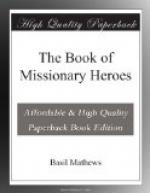Who was that strange woman (they asked one another), short and slight, with a face like yellow parchment and with short, straight brown hair, who smiled as she gathered the little tribe of African girls round her on the railway platform?
The telegraph boys and the news-boys gazed at her in astonishment. But they would have been transfixed with amazement if they had known a tenth of the wonder of the story of that heroic woman who, just as simply as she stood there on the Waverley platform, had mastered cannibals, conquered wild drunken chiefs brandishing loaded muskets, had faced hunger and thirst under the flaming heat and burning fevers of Africa, and walked unscathed by night through forests haunted by ferocious leopards, to triumph over regiments of frenzied savages drawn up for battle, had rescued from death hundreds of baby twins thrown out to be eaten by ants—and had now brought home to Scotland from West Africa four of these her rescued children.
Still more would those Scottish boys at Waverley Station have wondered, as they gazed on the little woman and her group of black children, if they had known that the woman who had done these things, Mary Slessor, had been a Scottish factory girl, who had toiled at her weaving machine from six in the morning till six at night amid the whirr of the belts, the flash of the shuttles, the rattle of the looms, and the roar of the great machines.
Born in Aberdeen, December 2, 1848, Mary Slessor was the daughter of a Scottish shoemaker. Her mother was a gentle and sweet-faced woman. After her father’s death Mary was the mainstay of the home. Working in a weaving shed in Dundee (whither the family moved when Mary was eleven) she educated herself while at her machine.
The Call to Africa
Like Livingstone, she taught herself with her book propped up on the machine at which she worked. She read his travels and heard the stories of his fight against slavery for Africa, till he became her hero.
One day the news flashed round the world: “Livingstone is dead. His heart is buried in Central Africa.” Mary had thrilled as she read the story of his heroic and lonely life. Now he had fallen. She heard in her heart the words that he had spoken:
“I go to Africa to try to make an open door....; do you carry out the work which I have begun. I LEAVE IT WITH YOU.”
As Mary sat, tired with her week’s work, in her pew in the church on Sunday, and thought of Livingstone’s call to Africa, she saw visions of far-off places of which she heard from the pulpit and read in her magazines—visions of a steaming river on the West Coast of Africa where the alligators slid from the mud banks into the water; visions of the barracoons on the shore in which the captured negroes were penned as they waited for the slave-ships; pictures of villages where trembling prisoners dipped their hands in boiling oil to test their guilt, and wives were strangled to go with their dead chief into the spirit-land; visions of the fierce chiefs who could order a score of men to be beheaded for a cannibal feast and then sell a hundred more to be hounded away into the outer darkness of slavery—the Calabar where the missionaries of her church were fighting the black darkness of the most savage people of the world.




